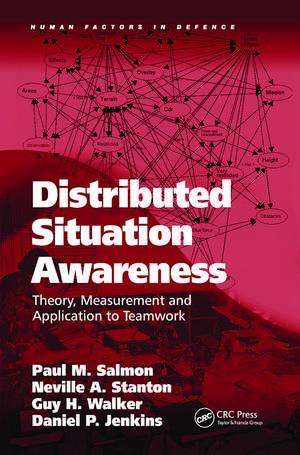Distributed Situation Awareness: Theory, Measurement and Application to Teamwork: Human Factors in Defence
Autor Paul M. Salmon, Neville a. Stanton, Daniel P. Jenkinsen Limba Engleză Hardback – 20 noi 2009
| Toate formatele și edițiile | Preț | Express |
|---|---|---|
| Paperback (1) | 487.02 lei 6-8 săpt. | |
| CRC Press – 31 mar 2017 | 487.02 lei 6-8 săpt. | |
| Hardback (1) | 1114.70 lei 6-8 săpt. | |
| CRC Press – 20 noi 2009 | 1114.70 lei 6-8 săpt. |
Din seria Human Factors in Defence
- 18%
 Preț: 1114.08 lei
Preț: 1114.08 lei - 8%
 Preț: 383.57 lei
Preț: 383.57 lei -
 Preț: 487.75 lei
Preț: 487.75 lei -
 Preț: 487.02 lei
Preț: 487.02 lei - 22%
 Preț: 324.16 lei
Preț: 324.16 lei - 15%
 Preț: 427.16 lei
Preț: 427.16 lei - 25%
 Preț: 340.62 lei
Preț: 340.62 lei - 15%
 Preț: 427.16 lei
Preț: 427.16 lei - 18%
 Preț: 1115.51 lei
Preț: 1115.51 lei -
 Preț: 489.00 lei
Preț: 489.00 lei - 15%
 Preț: 461.03 lei
Preț: 461.03 lei - 15%
 Preț: 568.28 lei
Preț: 568.28 lei - 18%
 Preț: 1108.56 lei
Preț: 1108.56 lei - 15%
 Preț: 422.76 lei
Preț: 422.76 lei - 15%
 Preț: 429.62 lei
Preț: 429.62 lei - 15%
 Preț: 427.16 lei
Preț: 427.16 lei - 26%
 Preț: 456.63 lei
Preț: 456.63 lei -
 Preț: 487.19 lei
Preț: 487.19 lei
Preț: 1114.70 lei
Preț vechi: 1359.39 lei
-18% Nou
Puncte Express: 1672
Preț estimativ în valută:
213.31€ • 228.09$ • 177.84£
213.31€ • 228.09$ • 177.84£
Carte tipărită la comandă
Livrare economică 18 aprilie-02 mai
Preluare comenzi: 021 569.72.76
Specificații
ISBN-13: 9780754670582
ISBN-10: 0754670589
Pagini: 266
Ilustrații: Includes 84 b&w illustrations
Dimensiuni: 156 x 234 x 23 mm
Greutate: 0.61 kg
Ediția:New ed
Editura: CRC Press
Colecția CRC Press
Seria Human Factors in Defence
ISBN-10: 0754670589
Pagini: 266
Ilustrații: Includes 84 b&w illustrations
Dimensiuni: 156 x 234 x 23 mm
Greutate: 0.61 kg
Ediția:New ed
Editura: CRC Press
Colecția CRC Press
Seria Human Factors in Defence
Public țintă
Academic and Professional Practice & DevelopmentCuprins
Contents: Introduction; What is really going on? Situation awareness literature review; How do we know what they know? Situation awareness measurement methods review; Distributed situation awareness: a new view on situation awareness in collaborative environments and its measurement; Distributed situation awareness in the real world: a case study in the energy distribution domain; Distributed situation awareness and network enabled capability systems: multinational experiment 4; Out with the old and in with the new: a comparison of distributed situation awareness using analogue and digital mission planning systems; Is it really better to share? Analysis of a new digital mission support system and implications for system design; A model of distributed awareness in complex collaborative environments; Conclusions for distributed situation awareness theory, measurement and teamwork; References; Index.
Recenzii
'Situation awareness is a term that has consumed both practitioners and the Human Factors community with no agreed approach despite volumes of publications on this topic. This well referenced book provides a comprehensive review of the nature of the concept and how it has been measured that is useful for both novices and researchers in this field. It does not duck controversy and criticises traditional individual- and team-based models of SA, proposing instead a distributed account of SA across agents and artefacts in order to more fully understand collaborative work activities. This approach emanates from the conceptualisation of distributed cognition in the mid 1990s and not only advances models of SA but also challenges us to consider how analyses of distributed SA should be carried out. Case studies are provided together with some solutions for carrying out such analyses. The book is refreshingly provocative, advances this area and has to be a recommended read for everybody interested in this topic...' John Patrick, Cardiff University, UK '"Situation awareness" (SA) has a central, almost mythical status within the pantheon of military concepts. In presenting their theory of distributed situation awareness (DSA), the authors make a radical departure from existing models.' Australian Defence Force Journal, September 2010 'Distributed Situation Awareness: Theory, Measurement and Application to Teamwork makes three broad contributions (literature reviews, case studies, and synthesis of findings), each of which makes a significant contribution to the understanding of SA. The book is well written, well referenced, with a logical structure and a consistent style (difficult to obtain in multi-author texts). Importantly, it ends with 18 very useful guidelines to assist designers of command and control systems to achieve distributed SA. Distributed Situation Awareness: Theory, Measurement and Application to Teamwork makes an excellent contribution to the understanding
Notă biografică
Paul M. Salmon, Neville A. Stanton, Daniel P. Jenkins
Descriere
This book presents an exhaustive review and evaluation of contemporary theoretical perspectives on SA and of a range of SA measurement approaches. A novel theory of DSA in complex sociotechnical systems is presented, followed by an original methodology for assessing SA and DSA in command and control environments. It contains several naturalistic case studies of command and control scenarios undertaken in numerous military domains, as well as one involving multiple high-consequence civilian domains.













